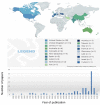Application of Artificial Intelligence in Community-Based Primary Health Care: Systematic Scoping Review and Critical Appraisal
- PMID: 34477556
- PMCID: PMC8449300
- DOI: 10.2196/29839
Application of Artificial Intelligence in Community-Based Primary Health Care: Systematic Scoping Review and Critical Appraisal
Abstract
Background: Research on the integration of artificial intelligence (AI) into community-based primary health care (CBPHC) has highlighted several advantages and disadvantages in practice regarding, for example, facilitating diagnosis and disease management, as well as doubts concerning the unintended harmful effects of this integration. However, there is a lack of evidence about a comprehensive knowledge synthesis that could shed light on AI systems tested or implemented in CBPHC.
Objective: We intended to identify and evaluate published studies that have tested or implemented AI in CBPHC settings.
Methods: We conducted a systematic scoping review informed by an earlier study and the Joanna Briggs Institute (JBI) scoping review framework and reported the findings according to PRISMA-ScR (Preferred Reporting Items for Systematic Reviews and Meta-Analysis-Scoping Reviews) reporting guidelines. An information specialist performed a comprehensive search from the date of inception until February 2020, in seven bibliographic databases: Cochrane Library, MEDLINE, EMBASE, Web of Science, Cumulative Index to Nursing and Allied Health Literature (CINAHL), ScienceDirect, and IEEE Xplore. The selected studies considered all populations who provide and receive care in CBPHC settings, AI interventions that had been implemented, tested, or both, and assessed outcomes related to patients, health care providers, or CBPHC systems. Risk of bias was assessed using the Prediction Model Risk of Bias Assessment Tool (PROBAST). Two authors independently screened the titles and abstracts of the identified records, read the selected full texts, and extracted data from the included studies using a validated extraction form. Disagreements were resolved by consensus, and if this was not possible, the opinion of a third reviewer was sought. A third reviewer also validated all the extracted data.
Results: We retrieved 22,113 documents. After the removal of duplicates, 16,870 documents were screened, and 90 peer-reviewed publications met our inclusion criteria. Machine learning (ML) (41/90, 45%), natural language processing (NLP) (24/90, 27%), and expert systems (17/90, 19%) were the most commonly studied AI interventions. These were primarily implemented for diagnosis, detection, or surveillance purposes. Neural networks (ie, convolutional neural networks and abductive networks) demonstrated the highest accuracy, considering the given database for the given clinical task. The risk of bias in diagnosis or prognosis studies was the lowest in the participant category (4/49, 4%) and the highest in the outcome category (22/49, 45%).
Conclusions: We observed variabilities in reporting the participants, types of AI methods, analyses, and outcomes, and highlighted the large gap in the effective development and implementation of AI in CBPHC. Further studies are needed to efficiently guide the development and implementation of AI interventions in CBPHC settings.
Keywords: artificial intelligence; community-based primary health care; machine learning; systematic scoping review.
©Samira Abbasgholizadeh Rahimi, France Légaré, Gauri Sharma, Patrick Archambault, Herve Tchala Vignon Zomahoun, Sam Chandavong, Nathalie Rheault, Sabrina T Wong, Lyse Langlois, Yves Couturier, Jose L Salmeron, Marie-Pierre Gagnon, Jean Légaré. Originally published in the Journal of Medical Internet Research (https://www.jmir.org), 03.09.2021.
Conflict of interest statement
Conflicts of Interest: None declared.
Figures




References
-
- Liyanage H, Liaw S, Jonnagaddala J, Schreiber R, Kuziemsky C, Terry AL, de Lusignan S. Artificial intelligence in primary health care: perceptions, issues, and challenges. Yearb Med Inform. 2019 Aug;28(1):41–46. doi: 10.1055/s-0039-1677901. http://www.thieme-connect.com/DOI/DOI?10.1055/s-0039-1677901 - DOI - PMC - PubMed
-
- He J, Baxter SL, Xu J, Xu J, Zhou X, Zhang K. The practical implementation of artificial intelligence technologies in medicine. Nat Med. 2019 Jan;25(1):30–36. doi: 10.1038/s41591-018-0307-0. http://europepmc.org/abstract/MED/30617336 10.1038/s41591-018-0307-0 - DOI - PMC - PubMed
-
- Lin SY, Mahoney MR, Sinsky CA. Ten ways artificial intelligence will transform primary care. J Gen Intern Med. 2019 Aug;34(8):1626–1630. doi: 10.1007/s11606-019-05035-1. http://europepmc.org/abstract/MED/31090027 10.1007/s11606-019-05035-1 - DOI - PMC - PubMed
-
- Community-Based Primary Health Care. [2021-07-28]. https://cihr-irsc.gc.ca/e/43626.html .
-
- Canadian Institutes of Health Research What is community-based primary health care? CBPHC Overview. 2015. [2021-07-28]. https://cihr-irsc.gc.ca/e/44079.html .
Publication types
MeSH terms
LinkOut - more resources
Full Text Sources
Miscellaneous

